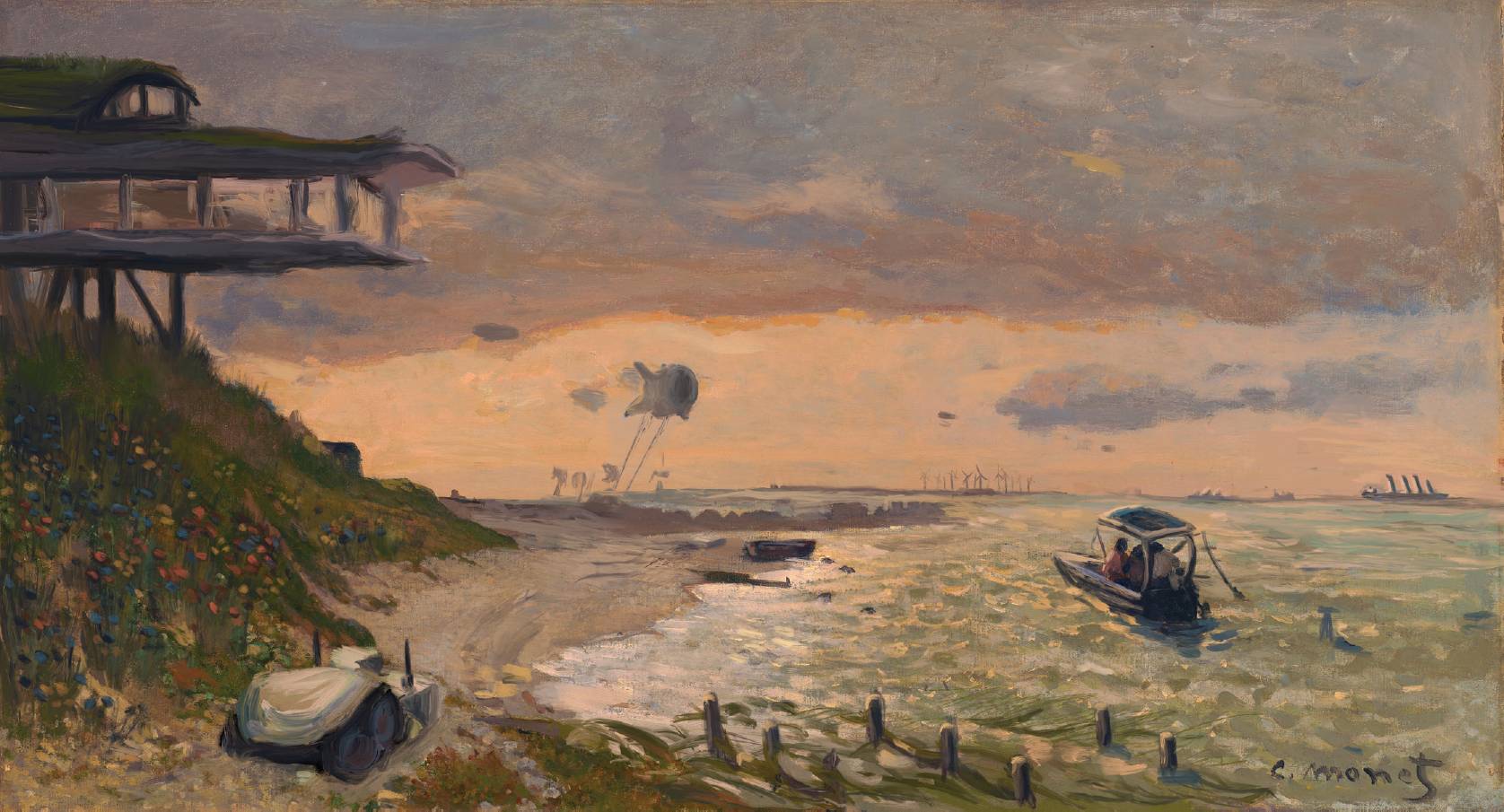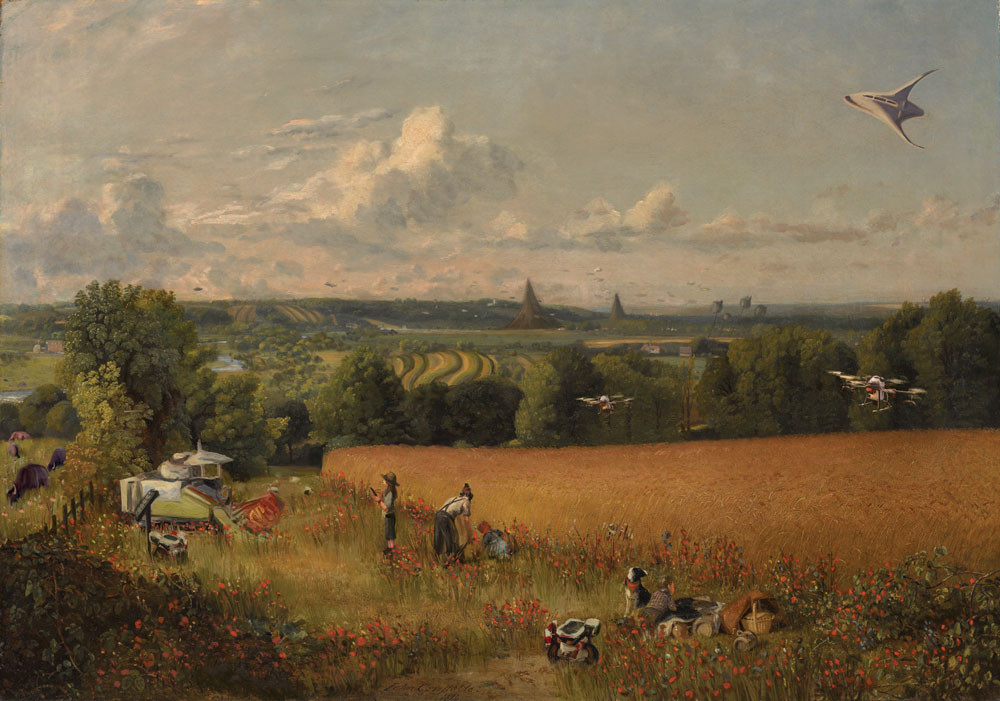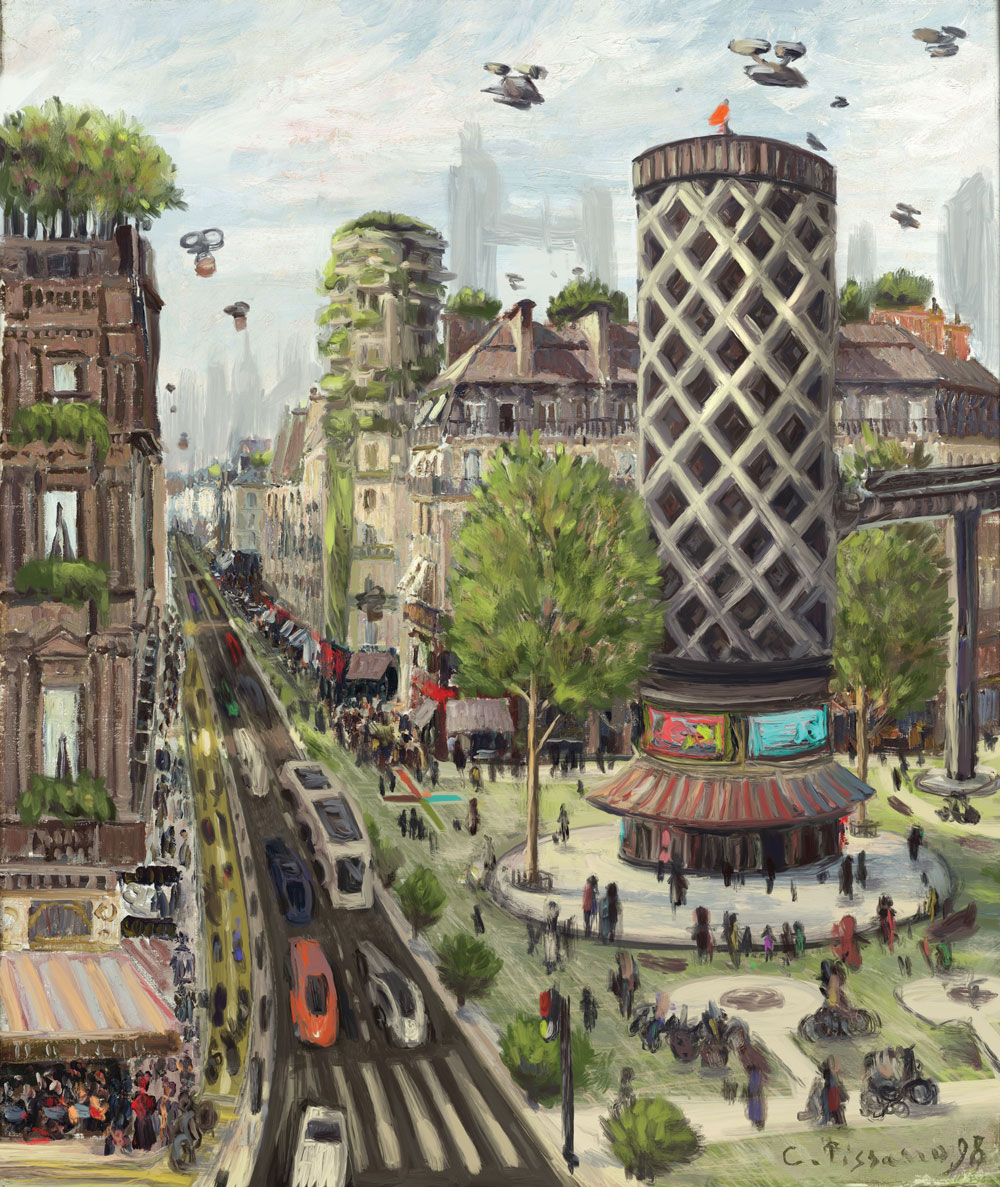Outreach
Engineering future masterpieces
Dr Rhys Morgan, Director of Engineering Education, Royal Academy of Engineering, talks to Abigail Tomkins

TOWARDS the end of 2021, the Royal Academy of Engineering digitally reworked four masterpieces by Vincent van Gogh, Claude Monet, John Constable and Camille Pissarro to include engineering innovations of the year 2050 – technology that it hopes will have helped the world achieve net zero carbon emissions.
The artist Ashly Lovett took the land and city scapes and transformed them to include agricultural robots, flying taxis, hyperloop, electric planes, vertical orchards and rooftop farms, while retaining the distinct style and sense of place of the originals.
The artworks were commissioned as part of the academy’s This is Engineering, a celebration of the varied careers and achievements of all the engineering professions.
This is Engineering hopes to impact the skills and diversity shortfalls that are common across engineering, particularly in the coming decades as we face the global challenge of climate change.
The re-imagined Factories at Clichy by Vincent van Gogh, The Wheat Field by John Constable, Rue Saint-Honoré by Camille Pissarro and The Seashore at Sainte-Adresse by Claude Monet were displayed during COP 26 at Strathclyde University, and are hosted online by Google Arts and Culture.
Dr Rhys Morgan, the Royal Academy of Engineering’s director of engineering education, spoke to Abigail Tomkins about the initiative and the conversations it hopes to start.
How did you come up with the idea?
It’s always challenging to break through with a message. We were looking at COP 26 and meeting net zero, and thinking what the world would look like in 2050. There are so many simulations of ‘the future’ but you can never actually predict what will happen.
You can have some good bets and 2050 is close enough for us to have some understanding of what’s possible and potentially likely to happen.
We thought about how people in the past have predicted the future, and those visions from the 1930s of cities filled with skyscrapers, and how now we’re moving away from that. We’re more attuned to the fact that we need to get back to nature and work with it to meet our carbon emissions targets. That led us to thinking about landscapes and the Impressionists. What would van Gogh or Monet think about today? What would their landscapes look like in 2050?

Monet’s The Seashore at Sainte-Adresse (1864) re-imagined for 2050. The artwork features a brighter palette to reflect cleaner air; a floating wind turbine; a reclaimed material structure with flexible solar-smart windows; a cargo ship with solar sails; rewilding; a beach cleaning robot; a solar-powered leisure boat; and a seagrass plantation.
Do adults attach a romanticism to landscape, where children might see the possibilities to build?
There is definitely a difference in the way children and adults approach things. Pre-school kids are proto-engineers, they are creative problem solvers. They’re building, they’re exploring, they’re demolishing and building again. Our education system and lack of hands-on and contextualised learning somehow loses that inherent engineer in us.
We were very conscious that if we were going to put this out into the world, there could be a backlash. If we tore through Constable’s lovely fields with hyperloop, we’d have people up in arms about engineers ruining the environment.
We were very conscious that if we were going to put this out into the world, there could be a backlash. If we tore through Constable’s lovely fields with hyperloop, we’d have people up in arms about engineers ruining the environment. We needed to reflect the fact that engineers are very considerate of the landscapes they work in.
One of the Engineering Council’s principles of sustainability is to do as little harm as possible, and to improve the natural environment where you’re working. We see that with civil engineering projects, there’s a lot of rewilding that goes on around bypasses for example, but that’s not always the impression people have.
How feasible is the technology that you’ve put in there?
Everything in there is potentially feasible and it is all going on now – it may be in a research phase or in very early development, but none of it is pie in the sky. We worked with a whole bunch of engineering experts across the disciplines; robotics and automation, mechanical, civil, aerospace engineering, pretty much everyone. It was a bit like being a kid in a sweet shop looking at what technology we could fit into the paintings. There was so much good stuff we could include, but we were conscious not to overload them.
In the Constable there is a plane that was designed by Dame Ann Dowling, the former president of the Royal Academy of Engineering, as part of the Silent Aircraft Initiative at Cambridge University. Engineers are also working on SABRE air-breathing jet engines that could minimise environmental noise and run on hydrogen fuel. The only exhaust from burning hydrogen is water vapour. It’s incredibly powerful and super fast – and that technology is being developed in the UK right now.
Another lovely feature in that painting is the drones flying over the field. Harper Adams University is using this technology at the moment to fly imaging systems over fields to assess the health of crops. If there’s an outbreak of aphids in a particular area, they release a box of ladybirds there. Technology is augmenting nature, helping it to get a head start.
A slightly hidden feature in this painting is a spiky tented structure. This came out of work Buro Happold is leading, and is a tented city. There’s one in Kazakhstan. It’s a bit like the Millennium Dome on a much larger scale. That to me is very futuristic. I can really imagine huge tented structures where people live underneath them in a controlled environment – a bit like Center Parcs!

Van Gogh’s Gogh’s Factories at Clichy (1887) re-imagined for 2050. The artwork features a clean sky, free from chimney smoke; electric air traffic; roof gardens; vertical gardens; vertical electric taxis; a hyperloop-style high-speed carbon neutral public transport system; anaerobic digesters; delivery drones; pixel farming; and precision agriculture.
How did you select the paintings?
We knew the artists we wanted to feature and we knew the type of landscapes that would work. There were some particular paintings that we couldn’t get due to limitations around copyright, but we’ve been introduced to some paintings we weren’t familiar with, and that has been a real delight.
Do you have a favourite?
I really like the Pissarro. I’m a city boy at heart and I’m a big fan of Paris. It was really interesting to play with the streetscape. It was important that we stuck to the original themes of the paintings. The Pissarro worked well for the technology you might find in an urban environment, whereas the Monet seascape worked well for renewable energy and seagrass plantations.

The Wheat Field (1816) by Constable re-imagined for 2050. The artwork features a hydrogen plane; wind turbines; tented buildings; strip and contour farming; agricultural drones; rewilding; autonomous harvesting; bison grazing on clover fields; wildflowers; robotic mower and docking station; and a robotic weeder.
How did Google get involved?
We’ve worked with Google Arts and Culture for a couple of years on our This is Engineering campaign. It hosts our Museum of Engineering Innovation, where we highlight various things in the world that are interesting and quirky.
The link with Google works for us as it demonstrates another aspect of engineering. Google calls itself an engineering company, because it recognises that engineering underpins what it does. There’s definitely been a split from computing over the last 10 years, where technology became sexy, yet engineering was still seen as dirty and oily. We lost a trick by not cementing more that connection between engineering and technology. Computers, mobile phones, AI – all of it is underpinned by engineering. Engineering is ubiquitous, but it suffers from being hidden in plain sight.
There’s a misleading perception of engineers, and it’s perpetuated in the media. You hear engineers are clearing the leaves from the lines of the railways, and no, they aren’t. That’s another occupation. We run This is Engineering Day every November to try and get the wider public to go, ‘oh, I never thought about that as engineering’. We specifically target young people through their social media channels, like YouTube, Instagram and Snapchat but we also recognise that it’s not just about influencing young people, we need to influence their parents and the wider public about the breadth of engineering. Working with Google Arts and Culture really helps that.

Pissarro’s La Rue Saint-Honoré (1898) re-imagined for 2050. The artwork features vertical taxis; rooftop orchards; rotating buildings; delivery drones; vertical gardens; monorail; a 10-storey solar-powered transport hub; digital billboards; cycle lanes; self driving cars; permeable pavements; and public spaces.
This is Engineering launched in 2018, has it made a difference?
I don’t think anyone is under any misunderstanding that a 13-year-old is going to suddenly follow a pathway to engineering because they’ve watched a video on their phone. It just doesn’t work like that. There are so many different influences and factors affecting their decision making.
We do this to contribute to a much wider landscape of activity that is trying to get more young people into engineering. They’ll watch this on their phones and think ‘wow, that’s a cool video, I hadn’t realised that was engineering’. And then they might do something in school, like a STEM club or activities in science, and they might think ‘ah, I saw that in that video’. They’re making connections. They’re building up their knowledge and understanding of engineering.
Are we making a difference? There are increasing numbers of young people doing engineering, but the rate of that increase isn’t any greater than young people going to universities generally. We’re not making extra levels of increase. We need to work smarter. Lots of organisations are doing this stuff, and we do need more coherent messaging.
Is the carbon challenge the trick we can’t miss in attracting young people to engineering?
We need to channel activism into ‘solutioneering’. Young people are not going to be able to contribute to change unless they have the relevant skills.
It is, but we have to think hard about how we channel that activism. We’ve seen Greta Thunberg and lots of young people challenging governments around the need for meeting net zero ambitions.
We need to channel that activism into ‘solutioneering’.
These young people are not going to be able to contribute to change unless they have the relevant skills.
And that goes back to getting young people, their parents, their influencers and the wider public understanding the role of engineers and how we’re going to contribute to meeting net zero targets and sustainability more generally in the very high tech 21st century that we live in.
Are you optimistic that things will be alright by 2050?
Am I optimistic that we will reach the 1º target? It’s going to be an incredibly difficult challenge. The UK will probably be among the leading countries in the world. We will have the engineers, the commitment and the society to drive politicians to do that. But we are a very tiny player in the global system and I don’t think other countries are going to move fast enough to make the change.
I think we’ll become more resilient. We have to. We need to think more about resilience and mitigate for uncertainty and risk in our engineering design. When we talk about a storm being a 100- year event, that doesn’t mean if it’s happened once it’s not going to happen for 100 years, it means that it will happen again and we need to make sure that our bridges don’t fall down again. Or if a bridge does fall down and the fibre optic cables running through it have snapped, we have other telecommunications in place for the emergency services.
We have a very fragile infrastructure that’s so interdependent at the moment. But actually, I am an optimist. I just think we need to double our efforts over the next 30 years.
Dr Rhys Morgan, Director of Engineering Education, Royal Academy of Engineering, was talking to Abigail Tomkins www.raeng.org.uk rhys.morgan@raeng.org.uk https://artsandculture.google.com/story/_gXRIIoYwfQtZA